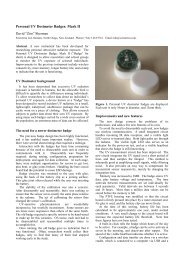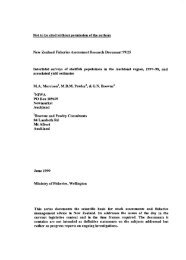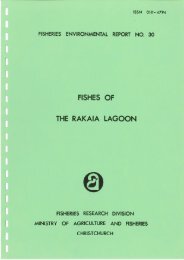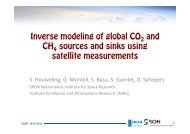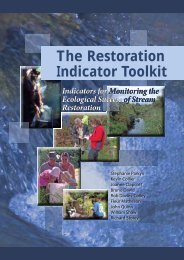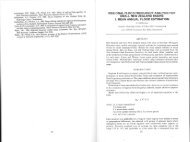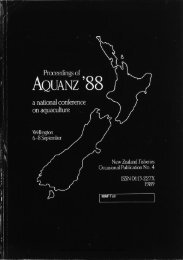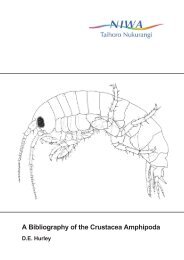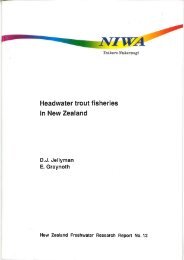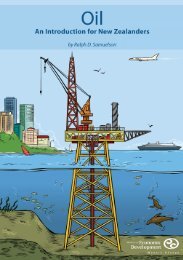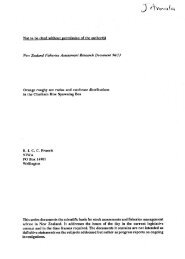WATER & SOIL - These are not the droids you are looking for.
WATER & SOIL - These are not the droids you are looking for.
WATER & SOIL - These are not the droids you are looking for.
Create successful ePaper yourself
Turn your PDF publications into a flip-book with our unique Google optimized e-Paper software.
Draper and Smith 1966). ln our case, <strong>the</strong> true value of <strong>the</strong><br />
dependent variable Qnu. is <strong>not</strong> known with certainty. It is<br />
subject to time sampling error and can only be estimated<br />
from <strong>the</strong> period of flow record available. The relative magnitudes<br />
of time sampling errors <strong>are</strong> indicated by <strong>the</strong> pooled<br />
Cy values in Figures 4.8 and 4.12.<br />
A second difficulty is that within a region some adjacent<br />
catchments may be subject to <strong>the</strong> same storms of large <strong>are</strong>al<br />
extent and a pair of series of annual maxima <strong>for</strong> such catchments<br />
is likely to be cross correlated: errors in estimates of<br />
Qo6, will <strong>the</strong>re<strong>for</strong>e <strong>not</strong> be random, but will also be correlated.<br />
In this situation regression analysis is still permissible,<br />
but estimation of <strong>the</strong> prediction error is more complex.<br />
An analysis of <strong>the</strong> situation is provided by Matalas<br />
and Gilroy (1968), and some practical examples <strong>are</strong> given<br />
by Hardison (1971).<br />
When a regional regression of log'o Q is calculated on a<br />
set of m catchment parameters, <strong>the</strong> standard deviation of<br />
<strong>the</strong> log,o Q about <strong>the</strong> regression expressed in log,o Q units<br />
is de<strong>not</strong>ed by Sp. lf <strong>the</strong>se deviations of <strong>the</strong> log,o Q from <strong>the</strong><br />
regression <strong>are</strong> normally distributed, <strong>the</strong>n <strong>the</strong> coefficient of<br />
variation of <strong>the</strong> untrans<strong>for</strong>med Q about <strong>the</strong> regression, C¡,<br />
is given by<br />
Cä = .*p (2.303 SR)' - I 47<br />
When Q is estimated from a flood record that is N years<br />
long, and <strong>the</strong> coeffìcient of variation of <strong>the</strong> annual maxima<br />
is de<strong>not</strong>ed Cy, <strong>the</strong> estimate of Q will differ from <strong>the</strong> population<br />
value (that would be obtained from a very long record)<br />
with a coel'ficient of variation of CylN.l.<br />
ci : ci /N"<br />
When Q is predicted using <strong>the</strong> regional regression it will As <strong>the</strong> quantity Nu could provide a useful guide <strong>for</strong> using<br />
differ from <strong>the</strong> population value, and <strong>the</strong> coefficient ofvar- <strong>the</strong> regression equations, it is evaluated <strong>for</strong> each of <strong>the</strong> reiation<br />
of <strong>the</strong> difference averaged over k sites, de<strong>not</strong>ed by gions toge<strong>the</strong>r with Cp <strong>for</strong> each region (Table 4.12). Esti-<br />
Table 4.12 Prediction errors and equivalent lengths of record.<br />
Cp, is calculated from Equation 4.8, which is derived from<br />
Hardison (1971).<br />
c'p : ch(t - + -<br />
tf+-, ) + ci (2q - r)/N6..... 4.8<br />
where p is <strong>the</strong> average cross-correlation between annual<br />
maxima series from pairs oi catchments in <strong>the</strong> region, and<br />
Nç is <strong>the</strong> average length of record. When <strong>the</strong>re <strong>are</strong> many<br />
uncorrelated records such that sampling errors tend to cancel,<br />
and <strong>the</strong> average record is short (k large, p small, N6<br />
small), <strong>the</strong>n Cþ can be less than CilNc, so rhat a better<br />
estimate is obtained from <strong>the</strong> regression at a site than from<br />
<strong>the</strong> record at a site.<br />
Note that Cp is an average prediction error, and will<br />
over-estimate errors on predictions <strong>for</strong> ungauged catchments<br />
whose parameters <strong>are</strong> near <strong>the</strong> mean value used in<br />
calculating <strong>the</strong> regression, and conversely. In New Zealand,<br />
no estimates of<strong>the</strong> interstation correlation coefficient q <strong>are</strong><br />
available, but typical values may reasonably be expected<br />
within <strong>the</strong> range 0.2 to 0.8. Three values of p (0.2, 0.5 and<br />
0.8), were <strong>the</strong>re<strong>for</strong>e used in evaluating Equation 4.8.<br />
Given <strong>the</strong> coefficient of variation of <strong>the</strong> prediction error<br />
Cp, ân estimate can be made of <strong>the</strong> length of record necessary<br />
to estimate Q with <strong>the</strong> same degree of accuracy as is<br />
given by <strong>the</strong> regression equation. If Nu is this equivalent<br />
length of record, anLd <strong>the</strong> prediction error is expressed as a<br />
percentage, <strong>the</strong>n<br />
49<br />
Region S¡<br />
(<strong>for</strong> regression<br />
of logarithms)<br />
Cvkm<br />
(no. of (no. of<br />
stations) regression<br />
variables)<br />
Nca<br />
(av length<br />
record)<br />
cR cP<br />
(Eqn 4.7) (Eqn 4.8)<br />
l"l,\ l"/"1<br />
N, Typical<br />
(Eqn 4.9) Nu<br />
(yrs)<br />
(yrs)<br />
Northland/<br />
Coromandel/<br />
East Cape<br />
Pumice<br />
East Coast Nl<br />
Wairarapai<br />
Manawatu/<br />
Wellington<br />
West Coast Nl<br />
West Coast Sl<br />
o.119<br />
o.128<br />
0.082<br />
o.118<br />
o.1 67<br />
0.148<br />
o.54<br />
o.54<br />
o.54<br />
o.40<br />
o.40<br />
0.36<br />
21<br />
14<br />
t1<br />
19<br />
25<br />
t9<br />
1 1.6<br />
12.O<br />
13.O<br />
13.5<br />
110<br />
9.4<br />
o.2<br />
o.5<br />
0.8<br />
o.2<br />
o.5<br />
o.8<br />
o.2<br />
0.5<br />
o.8<br />
o.2<br />
o.5<br />
o.8<br />
o.2<br />
o.5<br />
o.8<br />
o-2<br />
0.5<br />
o.8<br />
27.9<br />
21 .9<br />
27.9<br />
29.9<br />
29.9<br />
29.9<br />
1 9.1<br />
1 9.1<br />
1 9.1<br />
27.7<br />
27.7<br />
27.7<br />
39.9<br />
39.9<br />
39.9<br />
35.O<br />
35.O<br />
3 5.O<br />
27.5<br />
30.1<br />
32.5<br />
33.7<br />
35.8<br />
37.7<br />
19.4<br />
22.6<br />
25.4<br />
30.0<br />
31.1<br />
32.3<br />
41.6<br />
42.6<br />
43.6<br />
37.1<br />
38.1<br />
39.3<br />
39<br />
3.2<br />
2.3<br />
2.6<br />
2.3<br />
2.1<br />
7.8<br />
5.7<br />
4.5<br />
1.8<br />
1.7<br />
1.5<br />
o.9<br />
o.9<br />
0.9<br />
0.9<br />
o9<br />
o.8<br />
lnland<br />
Marlborough/<br />
Canterbury<br />
East Coast Sl<br />
Mackenzie/<br />
lnland Otago/<br />
Southland<br />
o.1 09<br />
o.1 05<br />
o.146<br />
0.66<br />
o.98<br />
o.66<br />
13<br />
1'l<br />
'I 5<br />
18.0 0.2<br />
0.5<br />
o.8<br />
8.4 0.2<br />
o.5<br />
o.8<br />
89 02<br />
o5<br />
o8<br />
25.O<br />
25.O<br />
25.O<br />
24.5<br />
24.5<br />
24.5<br />
34.5<br />
34.5<br />
34.5<br />
24.4<br />
27.2<br />
29.8<br />
12.5<br />
29.O<br />
39.1<br />
34.6<br />
38.6<br />
42.2<br />
7.3<br />
5.9<br />
4.9<br />
61.6<br />
11 .4<br />
6.3<br />
3.7<br />
2.9<br />
2.4<br />
Water & soil technical publication no. 20 (1982)<br />
75



